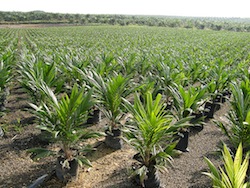 The United States Environmental Protection Agency (EPA) is currently reviewing whether to allow biofuels produced from palm oil as an allowable renewable fuel under the Renewable Fuel Standard (RFS2). The palm oil industry and the Indonesian and Malaysian governments are applying pressure to the EPA to reverse its finding that the greenhouse gas emissions resulting from palm oil production are too high to quality as a biofuel under RFS2.
The United States Environmental Protection Agency (EPA) is currently reviewing whether to allow biofuels produced from palm oil as an allowable renewable fuel under the Renewable Fuel Standard (RFS2). The palm oil industry and the Indonesian and Malaysian governments are applying pressure to the EPA to reverse its finding that the greenhouse gas emissions resulting from palm oil production are too high to quality as a biofuel under RFS2.
In a new study published in Nature Climate Change, by researchers from Yale and Stanford, expanding the use of palm oil in the Indonesian part of Borneo would significantly increase emissions. The area was the focus on the study because of its current use of palm oil, that includes conversion into biofuels. The study finds that if the use of palm oil is expanded:
- Palm oil expansion is projected to release more than 558 million metric tons of carbon dioxide to the atmosphere in 2020, more than all of Canada’s fossil fuel emissions.
- Palm oil expansion in Borneo alone is projected to contribute 18 percent to 22 percent of Indonesia’s 2020 C02- equivalent emissions.
- Full lease development would convert an additional 93,844 square kilometers of land in Borneo to oil palm plantations, including 41 percent intact forest. This is in addition to the three fold increase in land converted to palm plantations between 1990-2012, 90% of which was rainforest.
The study also links an increase in deforestation resulting from palm oil production in addition to palm oil production being a major source of greenhouse gas emissions.

